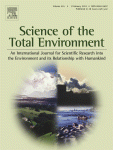Science of The Total Environment 433
Overview of articles on POPs in a new issue of the Science of The Total Environment journal.

Pages 151-160
Marta Llorca, Francisca Pérez, Marinella Farré, Sílvia Agramunt, Manolis Kogevinas, Damià Barceló
- An on-line method has been developed for the analysis of 18 perfluoroalkyl substances.
- The method is based on turbulent flow chromatography tandem mass spectrometry.
- The method was applied in 60 cord blood samples from 2 Mediterranean cities.
- Acidic compounds were more frequently found and the method was proved to be suitable for large-scale epidemiologic studies.
Pages 331-335
Chang Cui, Ying Tian, Lin Zhang, Yu Gao, Jun Jin, Pei Wang, Wenwei Ding, Xiaojin Wang, Rong Shi, Ying Wang
- We investigated PBDE levels in breast milk and influencing factors.
- The detection rates and levels of PBDEs were relatively high.
- PBDE levels were positively associated with maternal education and family income.
- The estimated daily intake by infants was below the no adverse effect level.
Pages 516-522
N.C. Deziel, J.R. Nuckols, J.S. Colt, A.J. De Roos, A. Pronk, C. Gourley, R.K. Severson, W. Cozen, J.R. Cerhan, P. Hartge, M.H. Ward
- We assessed house dust concentrations of PCDD/F and proximity to outdoor sources.
- We observed higher concentrations of PCDD/F in homes near cement kilns and roads.
- Further study of the contribution of these sources to PCDD/F exposure is warranted.
Pages 50-57
Zhe Lu, Fangang Zeng, Nandong Xue, Fasheng Li
- PAH concentrations varied largely in different sized fractions.
- The highest PAH concentrations were associated with clay and decreased in the order: clay > silt > coarse sand > fine sand.
- Soil organic matter (SOM) is an important factor to dominate the distribution of PAHs in this study site.
Deposition of organochlorine pesticides into the surface snow of East Antarctica
Pages 290-295
Jung-Ho Kang, Min-Hee Son, Soon Do Hur, Sungmin Hong, Hideaki Motoyama, Kotaro Fukui, Yoon-Seok Chang
- We present the concentrations of OCPs in surface snow of East Antarctica collected along a 1400-km inland traverse route.
- Of the 22 OCPs, α-HCH, γ-HCH, and HCB were frequently detected in the surface snow.
- The concentrations of α-HCH and γ-HCH slightly increased with increasing altitude along the traverse route.
- The surface snow in East Antarctica contains low levels of OCPs.
Pages 491-497
Mang Lu, De-Cai Zeng, Yong Liao, Bin Tong
- A first report of POP distribution in sediments of Poyang Lake, the largest freshwater lake in China.
- Potential sources of DDTs and Na-PCP were analyzed.
- PAH metabolites not reported were identified.
Spatial and temporal trends in PCBs in sediment along the lower Rhône River, France
Pages 189-197
Marc Desmet, Brice Mourier, Barbara J. Mahler, Peter C. Van Metre, Gwenaëlle Roux, Henri Persat, Irène Lefèvre, Annie Peretti, Emmanuel Chapron, Anaëlle Simonneau, Cécile Miège, Marc Babut
- We reconstructed trends in PCBs in the Rhône River, France, using sediment cores.
- PCB concentrations in sediments of the Rhône increase in a downstream direction.
- Concentrations of PCBs at the downstream sites remained elevated into the 1990s.
- PCBs in sediment downstream from Lyon are unlikely to decrease over the short term.
Pages 1-7
Seung Joo Lim, Peter Fox
- Sorption retained hydrophobic compounds in potable water reuse system.
- BIOWIN could be modified using the concepts of sorption and oxidation.
- The modified half lives were well matched with observed half lives.
- The RSS showed that BIOWIN should be modified in potable reuse system.
Pages 169-177
O. Samuel Sojinu, Oluwadayo O. Sonibare, Olusegun O. Ekundayo, Eddy Y. Zeng
- Σ25OCP ranged from 16 to 424 ng/g.
- OCPs resulted from intense farming activities.
- OCPs also from household pesticides usage.
- No fresh DDTs inputs in the area.
- Elephant grass has OCPs remediation potentials.
14.8.2012




